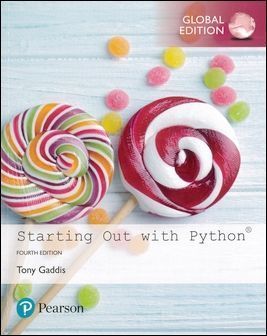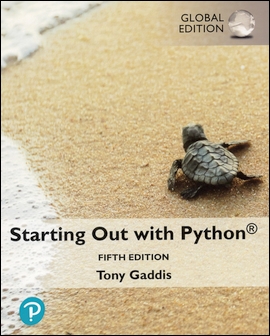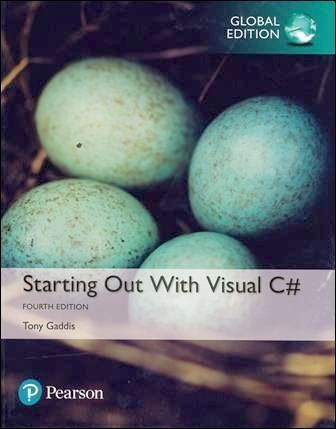Starting Out with Python 4/e (Global Edition)
售價
$
1,550
- 一般書籍
- ISBN:9781292225753
- 作者:Tony Gaddis
- 版次:4
- 年份:2019
- 出版商:Pearson Education
- 頁數/規格:744頁/平裝雙色
書籍介紹
本書特色
目錄
作者介紹
Description
A clear and student-friendly introduction to the fundamentals of Python
In Starting Out with Python®, 4th Edition, Tony Gaddis’ accessible coverage introduces students to the basics of programming in a high-level language. Python, an easy-to-learn and increasingly popular object-oriented language, allows readers to become comfortable with the fundamentals of programming without the troublesome syntax that can be challenging for novices. With the knowledge acquired using Python, students gain confidence in their skills and learn to recognize the logic behind developing high-quality programs.
Starting Out with Python discusses control structures, functions, arrays, and pointers before objects and classes. As with all Gaddis texts, clear and easy-to-read code listings, concise and practical real-world examples, focused explanations, and an abundance of exercises appear in every chapter. Updates to the 4th Edition include revised, improved problems throughout, and new Turtle Graphics sections that provide flexibility as assignable, optional material.
MyLab™ Programming not included. Students, if MyLab is a recommended/mandatory component of the course, please ask your instructor for the correct ISBN and course ID. MyLab should only be purchased when required by an instructor. Instructors, contact your Pearson rep for more information.
MyLab™ Programming is an online learning system designed to engage students and improve results. MyLabProgramming consists of programming exercises correlated to the concepts and objectives in this book. Through practice exercises and immediate, personalized feedback, MyLabProgramming improves the programming competence of beginning students who often struggle with the basic concepts of programming languages.
A clear and student-friendly introduction to the fundamentals of Python
In Starting Out with Python®, 4th Edition, Tony Gaddis’ accessible coverage introduces students to the basics of programming in a high-level language. Python, an easy-to-learn and increasingly popular object-oriented language, allows readers to become comfortable with the fundamentals of programming without the troublesome syntax that can be challenging for novices. With the knowledge acquired using Python, students gain confidence in their skills and learn to recognize the logic behind developing high-quality programs.
Starting Out with Python discusses control structures, functions, arrays, and pointers before objects and classes. As with all Gaddis texts, clear and easy-to-read code listings, concise and practical real-world examples, focused explanations, and an abundance of exercises appear in every chapter. Updates to the 4th Edition include revised, improved problems throughout, and new Turtle Graphics sections that provide flexibility as assignable, optional material.
MyLab™ Programming not included. Students, if MyLab is a recommended/mandatory component of the course, please ask your instructor for the correct ISBN and course ID. MyLab should only be purchased when required by an instructor. Instructors, contact your Pearson rep for more information.
MyLab™ Programming is an online learning system designed to engage students and improve results. MyLabProgramming consists of programming exercises correlated to the concepts and objectives in this book. Through practice exercises and immediate, personalized feedback, MyLabProgramming improves the programming competence of beginning students who often struggle with the basic concepts of programming languages.
Features
This title is a Pearson Global Edition. The Editorial team at Pearson has worked closely with educators around the world to include content which is especially relevant to students outside the United States.
About the Book
Teach Python from the fundamentals to the details
Features for student success
Gives students opportunities to apply programming concepts and skills
MyLab™ Programming not included. Students, if MyLab is a recommended/mandatory component of the course, please ask your instructor for the correct ISBN and course ID. MyLab should only be purchased when required by an instructor. Instructors, contact your Pearson representative for more information.
This title is a Pearson Global Edition. The Editorial team at Pearson has worked closely with educators around the world to include content which is especially relevant to students outside the United States.
About the Book
Teach Python from the fundamentals to the details
- Written with clear, easy-to-understand language, and rich with example programs that are concise, practical, and real-world oriented.
- The hundreds of Example Programs in the text are designed to highlight the topic currently being studied. Source code for these programs is provided so that students can run the programs themselves.
- Students not only learn how to implement the features and constructs of Python, but also why and when to use them.
- NEW! Turtle Graphics sections are designed with flexibility in mind and can be assigned as optional material, incorporated into your existing syllabus, or skipped altogether. The new sections that have been added to this edition are:
- Chapter 2: Introduction to Turtle Graphics
- Chapter 3: Determining the State of the Turtle
- Chapter 4: Using Loops to Draw Designs
- Chapter 5: Modularizing Turtle Graphics Code with Functions
- The Turtle Graphics library, which is a standard part of Python, is a fun and motivating way to introduce programming concepts to students who have never written code before. The library allows the student to write Python statements that draw graphics by moving a cursor on a canvas.
- Tips advise students on the best techniques for approaching different programming or animation problems.
Features for student success
- Concept Statements, Checkpoints, Notes, and Warnings throughout the book all call out important pieces of information for the student.
- Program Output is a sample of its screen output shown after each example program. This immediately shows the student how the program should function.
- In the Spotlight sections provides a programming problem and a detailed, step-by-step analysis showing the student how to solve it.
- VideoNotes developed specifically for this book are available at www.pearsonglobaleditions.com/gaddis. Icons appear throughout the text alerting the student to videos about specific topics. Students can follow along with the author as he works through each tutorial in the videos. Also, one programming project at the end of each chapter has an accompanying VideoNote that shows the student how to create the solution.
Gives students opportunities to apply programming concepts and skills
- A thorough and diverse set of review questions, such as fill-in-the-blank and short answer, check the student’s mastery of the basic material presented in each chapter. These are followed by exercises requiring problem solving and analysis, such as the Algorithm Workbench that contains questions on predicting the output of or finding the error in given code samples.
- EXPANDED! Several new programming problems have been added throughout the book.
- Programming Challenges are designed to solidify the student’s knowledge of the topics currently being studied. Each chapter offers a pool of programming exercises. In most cases the assignments present real-world problems to be solved.
MyLab™ Programming not included. Students, if MyLab is a recommended/mandatory component of the course, please ask your instructor for the correct ISBN and course ID. MyLab should only be purchased when required by an instructor. Instructors, contact your Pearson representative for more information.
- UPDATED! User Interface provides a new streamlined interface based on experienced user feedback. Course creation, configuration, and navigation are now easier than ever.
- EXPANDED! Exercise Editor now allows you to easily create new programming exercises. In addition to assigning the hundreds of programming exercises already available in MyLab Programming, you can create and assign programming exercises to customize your course.
- UPDATED! VideoNotes Tutorials provide step-by-step video tutorials specifically designed to enhance the programming concepts presented in Starting Out with Python. Students can view the entire problem-solving process outside of the classroom—when they need help the most.
- Interactive Practice provides first-hand programming experience in an interactive online environment.
- Immediate feedback for incorrect answers give students personalized feedback differentiating logical and compiler errors. The error messages include both the feedback from the compiler and plain English interpretations of likely causes for the incorrect answer.
- NEW! The Plagiarism Detection Tool alerts instructors of potential plagiarism issues by checking:
- Students’ average submission rate
- Students’ average number of attempts until correct
- Dynamic grading and assessment provide auto-grading of student assignments, saving you time and offering students immediate learning opportunities:
- A dynamic roster tracks their performance and maintains a record of submissions.
- The color-coded gradebook gives you a quick glance of your classes’ progress. Easily drill down to receive information on a single student’s performance or a specific problem. Gradebook results can be exported to Excel to use with your LMS.
Table of Contents
1. Introduction to Computers and Programming
2. Input, Processing, and Output
3. Decision Structures and Boolean Logic
4. Repetition Structures
5. Functions
6. Files and Exceptions
7. Lists and Tuples
8. More About Strings
9. Dictionaries and Sets
10. Classes and Object-Oriented Programming
11. Inheritance
12. Recursion
13. GUI Programming
Appendix A. Installing Python
Appendix B. Introduction to IDLE
Appendix C. The ASCII Character Set
Appendix D. Predefined Named Colors
Appendix E. More About the Import Statement
Appendix F. Installing Modules with the Pip Utility
Appendix G. Answers to Checkpoints
1. Introduction to Computers and Programming
2. Input, Processing, and Output
3. Decision Structures and Boolean Logic
4. Repetition Structures
5. Functions
6. Files and Exceptions
7. Lists and Tuples
8. More About Strings
9. Dictionaries and Sets
10. Classes and Object-Oriented Programming
11. Inheritance
12. Recursion
13. GUI Programming
Appendix A. Installing Python
Appendix B. Introduction to IDLE
Appendix C. The ASCII Character Set
Appendix D. Predefined Named Colors
Appendix E. More About the Import Statement
Appendix F. Installing Modules with the Pip Utility
Appendix G. Answers to Checkpoints
Tony Gaddis, Haywood Community College



